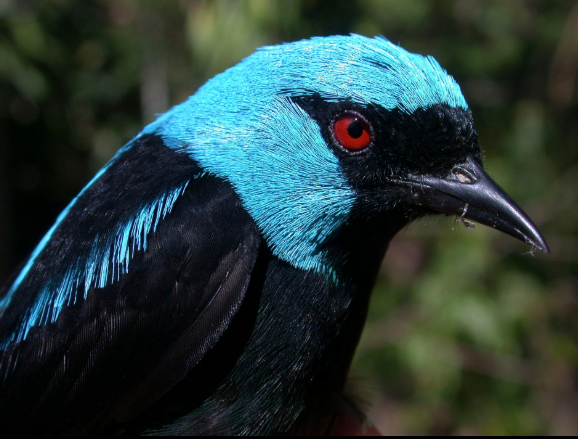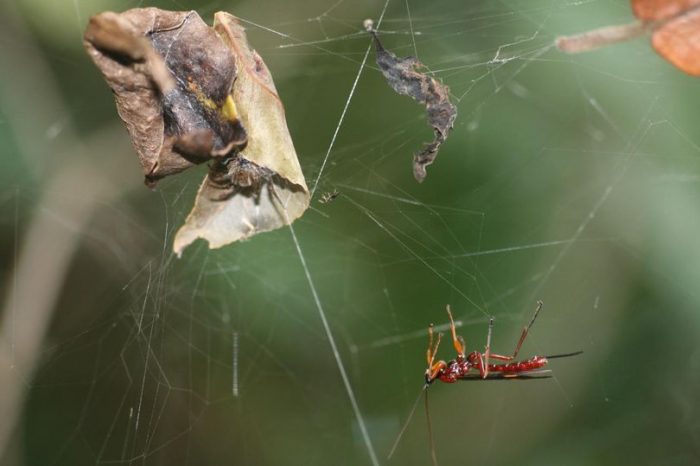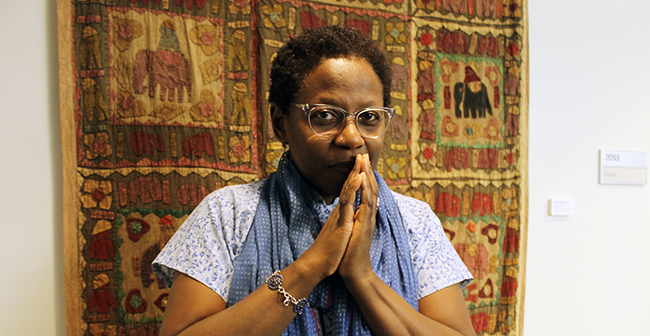ICYMI: Highlights from the week that was April 28 – May 4, 2019
No one can keep up with everything, so let us do it for you. We’ll gather the top Smithsonian stories from across the country and around the world each week so you’ll never be at a loss for conversation around the water cooler.
Former President Barack Obama warned about succumbing to fear even as we cowered at news of zombie spiders, algae invasions, disappearing moons and 60 years of volcanic eruptions.

Obama: Leaders who ‘feed fear typically are also ones who avoid facts’
CNN, April 29

Former President Barack Obama
Former President Barack Obama appeared to take a tacit swipe at President Donald Trump on Saturday, saying leaders who “feed fear typically are also ones who avoid facts.”
New Florida task force to study blue-green algae solutions
South Florida Sun Sentinel via Associated Press, April 29

Boats docked at Central Marine in Stuart are surrounded by blue green algae on June 29, 2016. Florida Gov. Ron DeSantis announced the formation of a task force to study nutrients from Lake Okeechobee and the effects on the state’s coasts (Greg Lovett / AP file)
Florida’s governor has created a new task force to help clean up the state’s lakes and rivers.
Gov. Ron DeSantis announced the formation of the Blue-green Algae Task Force during a news conference Monday at the Nathaniel P. Reed Hobe Sound National Wildlife Refuge.
National Geographic, April 29

The scarlet-thighed dacnis is one of many birds found in Costa Rica potentially affected by the conversion of tropical forest to coffee plantations. New research finds that while shade trees on coffee farms is helpful for some bird species, it’s not enough to stop the decline of others.
PHOTOGRAPH BY ÇAĞAN ŞEKERCIOĞLU
Sipping a collective 400 million cups a day, most coffee-loving Americans are likely unaware of how their cherished brew impacts tropical bird populations in some of the world’s most critical biodiversity hotspots.
Fortunately, University of Utah biologist Çağan Şekercioğlu and his team of researchers are on it.
Their landmark 12-year study of 57,255 individually banded birds representing 265 species at 19 Costa Rican sites sheds new light on how tropical birds, a key indicator of ecosystem health, are faring across a patchwork of habitats in a changing agricultural countryside. The team compared bird populations on primarily open coffee farms (with small amounts of shade) with those in remaining forested areas. Published Monday in the Proceedings of the National Academy of Sciences and partially funded by the National Geographic Society, the study reveals that even a small increase in coffee farm tree cover, from 7 to 13 percent to be exact, can provide a significant boost to birds. Read more from National Geographic.
Watch 60 Years Of Eruptions Shake The Planet In This Amazing Animation
Forbes, April 30

Boom! Here are 60 years of quakes and volcanic eruptions. GLOBAL VOLCANISM PROGRAM
After seeing how many people were interested in the 100-year animation of the world’s earthquakes, it only seemed fair that I’d point the way to a volcanological equivalent. So, courtesy of the Smithsonian Institution’s Global Volcanism Program, here it is! This spectacular web application – the Eruptions, Earthquakes & Emissions app, or E3 – shows not just earthquakes but volcanic eruptions since 1960, the date from which the record keeping of such things really took off.
The GVP already does a phenomenal job at keeping track of the world’s ongoing volcanic eruptions – 40 or so of which are going on at any one time, which, yes, is perfectly normal – but E3 certainly helps remind us just how volcanically active this planet really is. It’s not available as a video, but you can access the app if you click here. Feel free to zoom into various parts of the world, where plenty of smaller events can be seen popping up that otherwise fade into the background on the global scale.
The app already has a great FAQ, but here are some key points and bonus information here, just in case you’re curious. Read more from Forbes.
Terrifying wasps turn spiders into ZOMBIES before killing them, study reveals
Researchers from the Smithsonian Tropical Research Institute have revealed how wasps force spiders to weave a special web to suspend the wasp pupa, before killing the spider
The Mirror (UK), April 30

The wasps turn the spiders into zombies (Image: Marcelo O. Gonzaga)
The idea of a wasp turning a spider into a zombie may sound like the plot of a horror film.
But it’s very much a reality, and now a study has revealed how the wasps gain control.
Researchers from the Smithsonian Tropical Research Institute have revealed how parasitoid wasps force spiders to weave a special web to suspend the wasp pupa, before killing the spider.
The study suggests that this ‘zombification’ involves hacking existing web-spinning mechanisms by hijacking the spider’s molting hormone, ecdysone. Read more from The Mirror.
Skepticism grows over whether the first known exomoon exists
New analyses of Kepler and Hubble data dig into evidence for Kepler 1625b’s satellite
ScienceNews, April 30

MOON MISS? Astronomers revisited data used in detecting the first suspected moon orbiting a planet outside our solar system. Their results muddied the waters. This illustration shows what an Earth-like moon orbiting a Saturn-like planet might look like.
Hopes that astronomers found a moon orbiting a planet outside our solar system may be slowly dimming.
Two different groups of researchers took another look at data to search for a telltale dip in starlight that could suggest a moon was passing in front of the star Kepler 1625. Their conflicting results raise questions about whether the exomoon exists.
“When I reanalyzed the data, I don’t see that moonlike dip at all,” says Laura Kreidberg, an astronomer at the Harvard-Smithsonian Center for Astrophysics in Cambridge, Mass. She and colleagues reported the results in a paper posted at arXiv.org on April 25. Read more from ScienceNews.
Pete Seeger’s Legacy Gets Immortalized With ‘Smithsonian Folkways’ Collection
National Public Radio’s “All Things Considered,” May 1

Pete Seeger: The Smithsonian Folkways Collection is a six-CD collection of Seeger’s previously unreleased music, accompanied by a 200-page book.
Diana Davies/Courtesy of the artist
Though Pete Seeger, the heralded folk singer, songwriter and social activist died in 2014, his voice has left a lasting impression on American music. May 3, 2019 would have been Seeger’s 100th birthday and to mark the centennial, Smithsonian Folkways is set to release a six-CD collection titled Pete Seeger: The Smithsonian Folkways Collection.
This expansive collection features 20 previously unreleased tracks that spotlight Seeger’s pacifist methods, environmental activism and straightforward, inquisitive songwriting style. The collection also comes with a 200-page book on Seeger, written by Smithsonian Folkways curator and archivist Jeff Place.
Place spoke with NPR’s Audie Cornish about Seeger’s exploration period while fighting in World War II, the timelessness of his records and his impact on American folk. Hear the radio version of their conversation at the audio link and read on for more that didn’t make the broadcast. Read more and listen to the interview from NPR.
Will the Fourth Time Be the Charm? US Legislators Have Reintroduced a Bill to Open the National Museum of the American Latino
If approved, the museum will join the Smithsonian Institution museums on the National Mall in Washington.
Artnet News, May 1

WASHINGTON, DC – NOVEMBER 12: Rep. Jose Serrano (D-NY) joins veterans, servicemembers and aspiring recruits to call on Congress and President Barack Obama to move forward with immigration reform at the U.S. Capitol November 12, 2014 in Washington, DC. The news conference participants called on Obama to ‘go bold and go big’ and to use his executive authority to reform immigratoin if Congress could not get the job done. (Photo by Chip Somodevilla/Getty Images)
After several previous unsuccessful attempts, a group of bipartisan congressional leaders announced at a press conference this afternoon that they are reintroducing legislation to open the National Museum of the American Latino, which legislators want to build on the National Mall in Washington, DC. Among them are congressmen José E. Serrano (D-NY) and Will Hurd (R-TX) and senators John Cornyn (R-TX) and Bob Menendez (D-NJ).
According to language in the bill, the museum would be focused on illuminating Latino contributions to the history of the United States by providing for the collection, study, publication, and exhibition of objects related to Latino life, art, and history. The museum would also collaborate with other Smithsonian Institution museums and research centers to promote the appreciation of Latino culture in the US. Read more from Artnet News.
Soar Through the Heart of a Supernova in This Gorgeous New Simulation
Live Science, May 1

Technicolor debris blooms out of a dead star in the Smithsonian’s epic new 360-degree image.
Credit: Smithsonian Institution
When the universe’s largest stars run out of fuel and die, they explode in technicolor tsunamis of gas and dust that can stretch on into space for dozens of light-years. To see the full array of cosmic colors left behind by a star gone supernova, you generally need some pretty sophisticated telescopes capable of seeing light beyond the visible spectrum. But today, you can grab a front-row seat to those cosmic pyrotechnics by clicking over to this new 3D simulation released by the Smithsonian.
The interactive, 360-degree graphic allows armchair astronauts to navigate through the heart of a supernova remnant using just their mouse and arrow keys. The simulation shows the likeness of an actual supernova site called Cassiopeia A, a 10-light-year-wide cloud of stellar debris located in the Milky Way’s Cassiopeia constellation (about 11,000 light-years from Earth). The supernova’s colorful likeness was re-created using actual observations measured in gamma ray, infrared, ultraviolet, X-ray and radio wavelengths, provided by half a dozen observatories around the United States.Read more from Live Science
A Day in the Life with Smithsonian Folklife Festival Director Sabrina Lynn Motley
On Tap Magazine, April 27

Sabrina Lynn Motley (Photo by Trent Johnson)
Before pursuing roles as vice president of Vesper Society and senior director at Asia Society Texas Center, Sabrina Lynn Motley was a little girl often wandering the halls of various Los Angeles museums.
“Museums made sense to me because they were a place of learning,” she says. “But [they’re] also a place where you can hide out while your imagination soars.”
A professional life behind the scenes, tucked in offices within vast buildings housing art and artifacts, always made sense to Motley. After successful positions in programming and exhibition planning, the Smithsonian tapped her in 2013 as the new director of its famed Folklife Festival. Read more from On Tap Magazine.
Lawmakers renew push to create American Latino Smithsonian museum
The Hill, May 2

Robert Menedez (Photo © Greg Nash)
A bipartisan group of lawmakers on Tuesday reintroduced legislation to establish a national Latino museum in Washington, D.C., after a previous effort stalled in a previous legislative session.
Sens. Bob Menendez (D-N.J.) and John Cornyn (R-Texas) as well as Reps. José Serrano (D-N.Y.), Barbara Lee (D-Calif.), Joaquin Castro (D-Texas) and Will Hurd (R-Texas) reintroduced a bill that would establish a Smithsonian museum on the National Mall dedicated to Latino Americans and their history.
The National Museum of the American Latino Act would renew previous efforts to secure a location close to the Smithsonian’s other museums, such as the National Museum of African American History and Culture and the National Museum of the American Indian. Similar bipartisan bills to create such a museum have stalled in Congress. Read more from The Hill.
Posted: 7 May 2019






